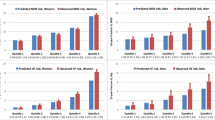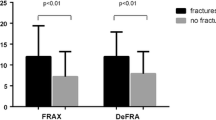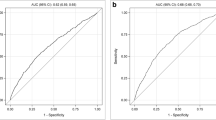Abstract
Summary
FRAXR incrementally improved prediction of incident major osteoporotic fractures compared with the simplified Canadian Association of Radiologists and Osteoporosis Canada (CAROC) tool.
Introduction
There is debate over the value of seemingly more complex fracture prediction tools over simpler fracture prediction tools. FRAXR and the simplified CAROC tool are both widely used in Canada for estimating 10-year probability of major osteoporotic fractures. We compared the performance of these tools for predicting fracture outcomes.
Methods
Using a bone densitometry registry for Manitoba, Canada, we identified 34,060 individuals age ≥50 years not receiving anti-osteoporosis therapy. Fracture Risk Assessment (FRAX) and CAROC were used to classify 10-year fracture risk as low (<10 %), moderate (10–20 %) and high (>20 %). Net reclassification improvement (NRI) was used to quantify the performance of FRAX versus CAROC.
Results
During mean 9.8 years of follow-up, 3905 individuals sustained fractures. There were 10 (of 35 total) situations where observed fracture risk fell outside of the predicted range, and all 10 discordances favoured FRAX. NRI among incident fracture cases was not significantly changed, but there was a significant improvement in risk categorization for those who remained fracture-free (+1.7 %, P < 0.001) resulting in overall improvement (NRI overall +0.028, P < 0.001). Within nine pre-specified subgroups, there was no case of significant worsening in NRI when using FRAX instead of CAROC. In absolute terms, only 36 individuals would need to be assessed using FRAX instead of CAROC to yield an improvement in prediction (8 among individuals with prior fracture and 4 among those with prolonged glucocorticoid use).
Conclusions
FRAX provides improvement in fracture risk prediction compared with the simplified CAROC tool in individuals referred for osteoporosis screening, supporting the use of FRAX as the international reference tool for fracture risk assessment.
Similar content being viewed by others
References
Johnell O, Kanis JA, Oden A et al (2005) Predictive value of BMD for hip and other fractures. J Bone Miner Res 20:1185–1194
Marshall D, Johnell O, Wedel H (1996) Meta-analysis of how well measures of bone mineral density predict occurrence of osteoporotic fractures. BMJ 312:1254–1259
Siris ES, YT C, Abbott TA et al (2004) Bone mineral density thresholds for pharmacological intervention to prevent fractures. Arch Intern Med 164:1108–1112
Schuit SC, Der Van KM, Weel AE et al (2004) Fracture incidence and association with bone mineral density in elderly men and women: the Rotterdam study. Bone 34:195–202
Stone KL, Seeley DG, Lui LY et al (2003) BMD at multiple sites and risk of fracture of multiple types: long-term results from the study of osteoporotic fractures. J Bone Miner Res 18:1947–1954
Cranney A, SA J, JF T et al (2007) Low bone mineral density and fracture burden in postmenopausal women. CMAJ 177:575–580
Rubin KH, Friis-Holmberg T, Hermann AP et al (2013) Risk assessment tools to identify women with increased risk of osteoporotic fracture: complexity or simplicity? A systematic review. J Bone Miner Res 28:1701–1717
Papaioannou A, Morin S, Cheung AM et al (2010) 2010 clinical practice guidelines for the diagnosis and management of osteoporosis in Canada: summary. CMAJ 182:1864–1873
Fraser LA, Langsetmo L, Berger C et al (2011) Fracture prediction and calibration of a Canadian FRAX(R) tool: a population-based report from CaMos. Osteoporos Int 22:829–837
Leslie WD, Lix LM, Johansson H et al (2010) Independent clinical validation of a Canadian FRAX tool: fracture prediction and model calibration. J Bone Miner Res 25:2350–2358
Leslie WD, Berger C, Langsetmo L et al (2011) Construction and validation of a simplified fracture risk assessment tool for Canadian women and men: results from the CaMos and Manitoba cohorts. Osteoporos Int 22:1873–1883
Leslie WD, Lix LM, Langsetmo L et al (2011) Construction of a FRAX((R)) model for the assessment of fracture probability in Canada and implications for treatment. Osteoporos Int 22:817–827
Kanis JA, On Behalf of the World Health Organization Scientific Group. Assessment of osteoporosis at the primary health-care level. Technical Report. Accessible At Http://Www.Shef.Ac.Uk/Frax/Pdfs/Who_Technical_Report.Pdf. 2007. Published By The University Of Sheffield
Kanis JA, Hans D, Cooper C et al (2011) Interpretation and use of FRAX in clinical practice. Osteoporos Int 22:2395–2411
Siminoski K, Leslie WD, Frame H et al (2005) Recommendations for bone mineral density reporting in Canada. Can Assoc Radiol J 56:178–188
Cook NR, Paynter NP (2011) Performance of reclassification statistics in comparing risk prediction models. Biom J 53:237–258
Leslie WD, Macwilliam L, Lix L et al (2005) A population-based study of osteoporosis testing and treatment following introduction of a new bone densitometry service. Osteoporos Int 16:773–782
Leslie WD, Caetano PA, Macwilliam LR et al (2005) Construction and validation of a population-based bone densitometry database. J Clin Densitom 8:25–30
Lm L, Azimaee M, Osman BA et al (2012) Osteoporosis-related fracture case definitions for population-based administrative data. BMC Public Health 12:301
O’Donnell S (2013) Use of administrative data for national surveillance of osteoporosis and related fractures in Canada: results from a feasibility study. Arch Osteoporos 8:143
Looker AC, Wahner HW, Dunn W et al (1998) Updated data on proximal femur bone mineral levels of US adults. Osteoporos Int 8:468–489
Kanis JA, Oden A, Johansson H et al (2009) FRAX and its applications to clinical practice. Bone 44:734–743
Leslie WD, Tsang JF, Caetano PA et al (2007) Effectiveness of bone density measurement for predicting osteoporotic fractures in clinical practice. J Clin Endocrinol Metab 92:77–81
Satagopan JM, Ben-Porat L, Berwick M et al (2004) A note on competing risks in survival data analysis. Br J Cancer 91:1229–1235
Pencina MJ, D’Agostino RB Sr, D’Agostino RB Jr et al (2008) Evaluating the added predictive ability of a new marker: from area under the ROC curve to reclassification and beyond. Stat Med 27:157–172
Leening MJ, Vedder MM, Witteman JC et al (2014) Net reclassification improvement: computation, interpretation, and controversies: a literature review and clinician’s guide. Ann Intern Med 160:122–131
Beattie K, Adachi J, Ioannidis G et al (2015) Estimating osteoporotic fracture risk following a wrist fracture: a tale of two systems. Arch Osteoporos 10:13
Acknowledgments
The authors acknowledge the Manitoba Centre for Health Policy (MCHP) for use of data contained in the Population Health Research Data Repository (HIPC Project Number 2011/2012-31). The results and conclusions are those of the authors, and no official endorsement by the MCHP, Manitoba Health or other data providers is intended or should be inferred. This article has been reviewed and approved by the members of the Manitoba Bone Density Program Committee.
LML is supported by a Manitoba Research Chair. SRM holds the Endowed Chair in Patient Health Management (Faculties of Medicine and Dentistry and Pharmacy and Pharmaceutical Sciences, University of Alberta).
Author information
Authors and Affiliations
Corresponding author
Ethics declarations
Conflicts of interest
None.
Financial activities outside the submitted work (last 3 years): WDL: Speaker fees Amgen, Eli Lily and Novartis and research grants Amgen (all paid to institution). RGJ: Consultancy fees and speaker honoraria: Amgen, Merck and Lilly and research grant Amgen. EVM: Consultancy fees, research funding and/or speaker fees from ActiveSignal, Amgen, AstraZeneca, Consilient Healthcare, GSK, Hologic, Internis, Lilly, Medtronic, Merck, Novartis, Pfizer, Roche, Sanofi-Aventis, Servier, Synexus, Tethys, UCB and Warner Chilcott and research support from ARUK, I3 Innovus, MRC, IOF and Unilever. JAK: Ad hoc consulting AgNovos Healthcare, Amgen, D3A, Lilly and Medimaps; research support Asahi, GSK, Lilly, Medtronic, Novartis, Pfizer, Radius Health, Roche, Sanofi-Aventis, Servier and Warner-Chilcott; and speaker’s fees Amgen, Pfizer, Servier and Takeda.
SRM, LML, HJ and AO have nothing to disclose.
Personal non-pecuniary interests: WDL: Director of the Manitoba Bone Mineral Density Program and President of the International Society for Clinical Densitometry. JAK: Architect of FRAX and President, International Osteoporosis Foundation.
Funding
No funding support was received for this research.
Rights and permissions
About this article
Cite this article
Leslie, W.D., Majumdar, S.R., Lix, L.M. et al. Direct comparison of FRAXR and a simplified fracture risk assessment tool in routine clinical practice: a registry-based cohort study. Osteoporos Int 27, 2689–2695 (2016). https://doi.org/10.1007/s00198-016-3613-8
Received:
Accepted:
Published:
Issue Date:
DOI: https://doi.org/10.1007/s00198-016-3613-8




